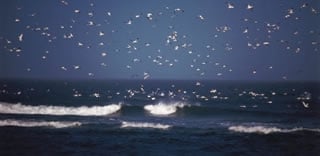
For striped bass and those who pursue them, the Outer Banks of North Carolina serves as a winter resort. Or last resort, for this is the final stop on the fish’s southern migration and the last place anglers can reasonably hope to catch them before spring. From Corolla to Cape Lookout, big bass luxuriate in these “warm” southern waters, slurping down menhaden along the sandy beaches and lining up in area inlets to feast on a buffet of eels. Their goal: to chow down and increase their fat reserves before moving offshore.
Hot on their heels is a horde of bass fanatics, many of them towing boats or loaded with surf gear. For these diehard anglers, the Outer Banks offer a final striper fix before calling it quits for the season, and many have made the trip an annual tradition.
The Outer Banks are easy to reach, yet isolated enough to provide a sense of frontier adventure. In late fall and winter, when the beaches are free of tourists, the area becomes the near-exclusive haunt of fishermen. Hotel parking lots are jammed with boat trailers, “Bait & Tackle” signs appear in front of grocery stores and gift shops, and the restaurants are packed at 6:00 a.m. Talk of fish and fishing hangs heavy in the air, and everyone has the same goal: to catch the last and best of the striper run before it’s too late.

Binging striped bass feed on loads of bait off these beaches in preparation for heading offshore.|
Eeling the Inlets
There are two basic strategies for catching stripers off the Outer Banks: fishing eels in the inlets and working the menhaden (bunker) schools along the beaches. Eeling comes first. From Halloween to New Years, adult American eels make their annual migration out of Albemarle and Pamlico Sounds, and waiting to greet them at Hatteras and Oregon Inlets are big stripers. This is the time to toss live eels into the turbulent waters of the inlet shoals. Hard-core striper hunter Harrison Finney of Frisco Rod and Gun usually does best on an outgoing tide. He suggests drifting past the shoals and lobbing eels into the whitewater.
Rigging up for eel fishing is really quite simple, according to Finney. Simply snell a 7/0 circle hook to 18 inches of 50-pound fluorocarbon leader tied to a two- to four-ounce trolling sinker. Then clip the sinker to a snap swivel attached to 20-pound mono spooled on a heavy-action spinning outfit. Hook the eel through the head and cast it into the turbulent water over the bars. When a striper hits, give it a second to suck down the eel, then point the rod at the fish and reel until the line comes tight. The circle hook should lodge in the corner of the fish’s mouth.
Fishing the inlet bars is no walk in the park, and rough weather can make things downright dangerous, especially for newcomers. Luckily, there’s usually plenty of company on the shoals. After arriving on scene, simply follow the lead of the other anglers. At Oregon Inlet, the boats drift the shoals, lining up in a long procession and taking turns passing over the shallows. At Hatteras, the common strategy is to anchor inside the breakers and cast eels into the whitewater.
Working the Beaches
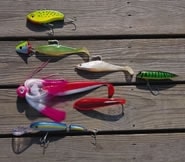
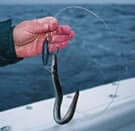
(top) Off the Outer Banks, the angler’s arsenal should include deep-diving plugs and jigs that get down into the strike zone of the big fish. (bottom) Eels are rigged on circle hooks and fished behind an in-line trolling sinker when fishing the inlets.|
Once the eel migration ends, the focus of both fish and fishermen shifts to the schools of menhaden that gather just off the beaches. To find the action, simply look for flocks of gannets diving on the menhaden schools. The stripers attack from the edges of the school, boiling on the surface and swallowing bunker whole.
When they’re in a feeding frenzy, they’ll usually pounce on anything that hits the water. Tossing topwater plugs on 20-pound spinning or baitcasting gear offers the most excitement, but be sure to replace any treble hooks with singles to make release easier.
Fly fishermen can also have a blast when the fish are busting on top. Keith Shidemantle of Hatteras Village recommends using a ten-weight rod with an intermediate sinking line. A big, olive-over-white Deceiver tied on a 2/0 to 3/0 hook is usually all it takes to score.
If the fish are holding deeper, try a two-ounce bucktail fished on a heavy-action outfit rated for 30-pound line. Retrieve the lure at different speeds, through different levels of the water column, until you find the fish. Obviously, a good depthsounder will help you locate the concentrations of bait and bass.
On the Troll
As exciting as the surface action can be, the stripers aren’t always so easy to find and catch. One day they may be in front of Oregon Inlet, while the next will find them 30 miles north off Corolla or south off Rodanthe. Even on Diamond Shoals and off Cape Lookout, the fish move around, one day feeding in the surf and the next day cruising the sloughs. When the bait and fish are scattered, trolling big spoons and plugs is the way to go.
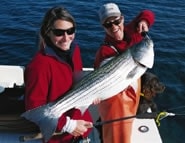
When the fish are not breaking on the surface, bucktail jigs, such as this one tipped with a chartreuse curl-tail soft-plastic grub, usually do the trick.|
Bill McGaskill of Whalebone Tackle in Manteo always starts the morning by trolling just off the beach. “The fish hang close to shore at dawn,” he says, “then move offshore at mid-day before moving back to the beach in the evening.”
The typical trolling weapons are big plugs such as the Mann’s Stretch 25+ or Magnum Maniac, which cover the upper and middle portions of the water column, and three-way “Mojo” rigs armed with spoons or jigs that swim just above the bottom. Plugs should be fished on heavy-action trolling outfits loaded with 30-pound mono. Mojo rigs can be fished on the same tackle loaded with 60-pound braided line.
A Mojo rig starts with a 1/0 three-way swivel. Tie four feet of 80-pound mono to one eye of the swivel and 18 feet of the same material to a second eye. At the end of the short leader, tie on an eight- to 32-ounce Mojo sinker (size will depend on water depth), which resembles a giant bucktail jig. On the long leader, tie on a big spoon, such as a 13/0 Crippled Alewife or a No. 3 1/2 Huntington Drone, or go with a big jig, such as a nine-inch Storm Swim Shad. Drop the Mojo rig to the bottom, then crank it up five or six turns or until the sinker bounces bottom every few seconds.
Pull two Mojos down the center and a plug off each gunwale. Lastly, rig a seven-inch Tomic plug on 20 feet of 80-pound leader behind an eight-ounce trolling sinker and drop it way back down the center of the spread.
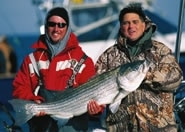
Bundle up to brave the cool conditions – blue skies and outrageous fishing make it worth your while.|
Some anglers prefer dark-colored lures on overcast days and light colors when the sky is clear. Others run light colors on one side of the boat and dark on the other to see what the fish want. Most everyone matches the color of the Mojo sinker to the color of the trailing lure. The key is to troll very slowly, and it sometimes helps to take the boat out of gear or drop the lines back even farther to convince a lazy striper to bite.
Weather Watch
The first northwest blow that drops the air temperature into the 50s will turn on the striper bite. The fish like water temperatures from 55 degrees to 45 degrees, but will suffer colder water if the bait is thick. The best fishing always seems to take place on the coldest days, so be sure to bring appropriate clothing.
Whether trolling the ocean or eeling the inlets, the best days for fishing are the ones when you can get away from the dock. During hard Nor’easters, the stripers may be working just off the beach, but no one can get out to catch them. In general, an easterly blow will shut down Oregon Inlet, while a southwesterly will close Hatteras Inlet. Anytime the tide and wind are opposed, the inlets will be a wild rollercoaster ride. Always make note of the tide and wind before venturing out, and time your return through the inlet to coincide with the best conditions.
| ### North Carolina Striper RegulationsAnglers fishing coastal waters of North Carolina are allowed to keep two striped bass over 28 inches per person per day. The ocean striped bass season is open year-round, but limited to state waters within three miles of the beach.Striper season in Albemarle Sound is open from mid-October until the end of December. During this time, fishermen are allowed two stripers bigger than 18 inches per day. However, fish can only be kept on Wednesday, Friday, Saturday and Sunday.Beginning January 1, 2006, anglers will be required to have a salt water fishing license. To check the latest regulations, find out more about the license, or get an up-to-date fishing report, visit the North Carolina Division of Marine Fisheries website at www.ncfisheries.net or call (252) 726-7021 or (800) 682-2632. – Ric Burnley |
Both inlets can be treacherous, especially for the uninitiated. The safest course is to follow the local charter boats (they leave at 5:30 a.m.) through the channel. Fishing on Diamond Shoals is also tricky, and should only be attempted on bluebird days.
Beating the Crowds
Like any vacation, half the fun of fishing the Outer Banks is getting there. When the striper run is on, thousands of anglers descend on the launch ramps and marinas. During last season’s holiday-season striper blitz, trucks pulling boat trailers were backed up for miles around Oregon Inlet.
The best way to beat the crowds is get to the ramp early. Also, check out the launch facility in Mann’s Harbor, which is less crowded and only a few miles from the inlet. Another way to avoid the insanity is to fish Diamond Shoals, which is just as productive, but not as heavily fished.
In the last few years, the striper schools have traveled as far south as Cape Lookout. From the end of December to the end of February, more and more anglers have been targeting big stripers on the East Side beaches and along Cape Lookout Shoals. Bob Pasefield at Harkers Island Fishing Center says that the striper fishing out of Beaufort Inlet “gets better and better each year, and they’re all big fish.”
Wherever you choose to hunt trophy stripers along the Outer Banks, you’ll find plenty of friendly people and comfortable accommodations. Just because the striper fishing at home is over doesn’t mean you have to store your gear and winterize your boat. Follow the stripers to their winter resort and enjoy the ultimate fishing vacation.
| ### If You Go…#### BOAT RAMPSOREGON INLET****National Park Service Boat Ramp Oregon Inlet Fishing Center off Highway 12Washington Baum Bridge Boat Ramp Off Highway 64 Across from Pirate’s Cove MarinaHATTERAS INLET****Teach’s Lair (888) 868-2460; (252) 986-2460 www.teachslair.comVillage Marina (252) 986-2522 www.villagemarinahatteras.comHatteras Harbor (800) 676-4939 www.hatterasharbor.comFrisco Cove Marina (252) 959-4242CAPE LOOKOUT****Harkers Island Fishing Center (252) 728-3907 www.harkersmarina.comMorehead Sports Marina (252) 726-5676Morehead City City Park, 10th and Arendell Street#### MARINAS & CHARTER BOAT RENTALSOREGON INLET****Pirate’s Cove Marina (800) 367-4728 www.fishpiratescove.comOregon Inlet Fishing Center (800) 272-5199 www.oregoninlet.comThicket Lump Marina (252) 473-4500HATTERAS INLET****Oden’s Dock (888) 544-8115 www.odensdock.comHatteras Landing (800) 551-8478 www.hatteraslanding.comBEAUFORT INLET****Joe Shute’s Bait and Tackle (800) 868-0941 www.captjoes.comMorehead City Fishing Center (800) 572-9209Captain Stacy Fishing Center (800) 533-9417#### BAIT & TACKLEOREGON INLET****TW’s Bait and Tackle (252) 453-3339 www.twstackle.comTI’s Bait and Tackle (252) 441-3166 www.tistackle.comWhalebone Tackle (252) 441-7413HATTERAS INLET****Frisco Tackle (252) 995-4361Frisco Rod and Gun (252) 995-5366 www.friscorodgun.comRed Drum Tackle (252) 995-5414 www.reddrumtackle.com#### GENERAL INFORMATIONHATTERAS ISLAND****Outer Banks Chamber of Commerce (252) 441-8144 www.outerbankschamber.comCHRYSTAL COAST****Carteret Chamber of Commerce (252) 726-6350 www.nccoastchamber.com |









